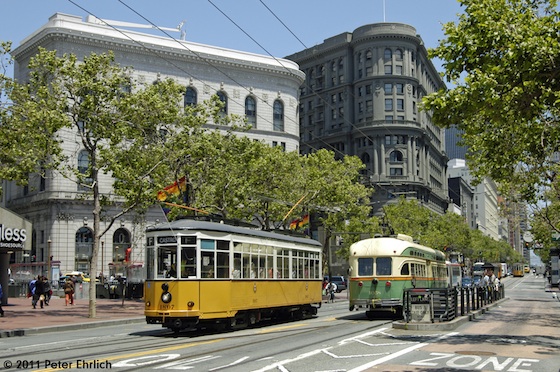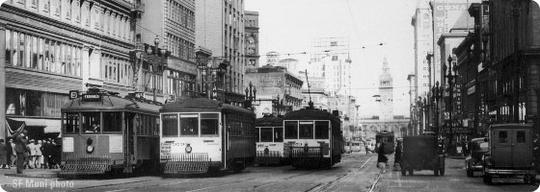Those catching up on their reading over this Memorial Day weekend should take a look at this SF Streetsblog post about Market Street’s future. The city has been planning to repave our main stem in 2015, but the project has grown into a comprehensive reenvisioning of what a main street means to a city in the 21st century.
The reduction of automobile traffic on Market in the past year or so has greatly stimulated more bicycle use; provision of safer-feeling bike lanes on some blocks has accelerated that trend. Accordingly, our friends at the Bicycle Coalition are deeply involved in the planning effort for the “new” Market Street.
We at Market Street Railway want to spur a similar level of advocacy and involvement behind improving conditions for transit on Market, specifically the F-line. Streetcars are, after all, not only a traditional part of Market (rail transit on Market goes back to 1860!) but also pulse inside that artery. The steel ribbons of track run continuously from Castro to the Ferry Building, figuratively tying the street together its entire length. And more than that, providing truly attractive transit throughout the corridor.

Market and Powell today, Peter Ehrlich photo.
We believe the F-line is even more essential to Market’s future than it is to its present. Streetcars extend the walkable range for pedestrians. As an example, frequent F-line service would make it possible for Financial District workers to patronize lunch spots in mid-Market, when it develops. Similarly, residents in such forthcoming developments as the 2,000 unit Trinity property at Eighth and Market can pop up to Upper Market/Castro for convenient shopping as well as down toward Union Square, distances too far (or too lengthy in terms of time) for many to walk. (Before you say it, allow me. Yes, buses can provide the same link, but the evidence is clear that many riders prefer rail, and we’re talking about discretionary trips here.)
Two of our board members, Nick Figone and Todd Lappin, are participating in the public planning process for Market Street, along with MSR member Jeremy Whiteman. We hope everyone interested in the role streetcars play in keeping Market Street vital will make their voices heard, whether they’re MSR members or not (though we’d love you to join our organization of course).
We’re focused on these issues, for starters:
– More attractive streetcar boarding islands, enlarged where possible
– Ticket machines at the busiest stops, combined with Proof of Payment (POP) operation and refined signal timing to reduce the time F-line streetcars spend at stops.
– Better signage to make the streetcars easier to use for non-regular riders
– Additional controls on automobile traffic on Market where such actions would make transit and bicycles move more quickly and safely.
On a personal note, I lived through the last redesign of Market Street, following BART construction in the late 1960s. My family ran a delicatessen on Market at Grant Avenue and we, along with the other businesses, were promised a grand boulevard without those nasty old streetcars. Hah! Fooled them! Yep, the planners wanted almost all the transit off Market (except diesel shuttle buses). Now they’ve learned that attractive transit contributes to the street’s vitality, rather than sapping it. Trouble is, the redesign didn’t account for the retention of transit boarding islands in the center lane, nor for the rise of bicycling as a means of commuting. So this is our chance to get it right.
This project is just getting underway so it’s a great time to get involved. You can find information on how to participate here.

They might make something of Mid-Market without doing something about the lower TL, which has become a cultural desert, but it will be a heroic pull, and a lot of the credit will probably go to the massive Trinity Apartment complex being built on the site of the old Crystal Palace Market, at 8th and Market Streets. “Up From The Deep, the Hotel Project”, is a great local website dedicated to the Tenderloin, Mid-Market and the 6th street corridor. Not only are the photographs of the structures extensive and often gorgeous, period photos of the recent Tenderloin are included. You’ll see a seedy TL from the seventies that is nonetheless vibrant with restaurants and other legit businesses, in comparison to the modern lower TL, now a warehouse district for the elderly and otherwise disadvantaged, with either social services offices in the retail spaces at street level, or nothing at all. The folks upstairs can’t, or are unable to afford to, come downstairs to participate. Thus, if the TL is to contribute to mid-Market, the retail spaces need to be reopened for retail and the social services offices need to be moved elsewhere. We need to create a draw that will flow down to Market, since the installed population is too old, or too poor to do the job.
Market street is like a river, and mid-Market has stagnated because nothing feeds it from the north, between fifth and Van Ness, and even less contributes from the south, between sixth and thirteenth. In essence, Market street’s tributaries have been dammed dry, and thus nothing flows into Market street. We’re not going to change the demographics of the TL for at least fifteen years (until the old die off) and while we can build up SOMA in the immediate area, our best bet is to work on getting the storefronts in the lower TL open for business, and with the entire SFPD HQ moving into the Civic Center, (into the old Federal Building on UN Plaza at Hyde) the timing couldn’t be better.
The “F” line is essential to Market Street, but without something to spur economic activity in the Lower TL and along Mission Street, Mid-Market’s recovery could still be a long way off, no matter how they redesign the actual boulevard.